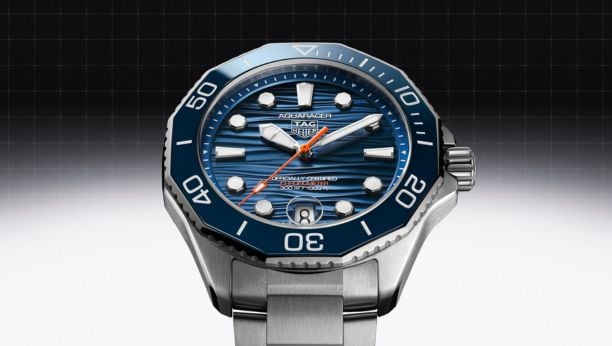VINTAGE COLLECTION
TAG HEUER AQUARACER
Heuer introduced its first dive watches in 1978, and after offering the entirely utilitarian 1000 Series models, broadened its collection of dive watches in 1982, to add elements of fashion and broader appeal, with the arrival of the 2000 Series. With the success of this diverse range of dive watches, and the intervening addition of other collections that offered greater elegance than the traditional dive watch, by 2004 the 2000 Series was renamed “Aquaracer” and would return to offering the most rugged and reliable tools for diving. Since that time, the Aquaracer collection has incorporated a broad variety of styles, colors, materials and movements, including both three-hand watches and chronographs, with the touchstone of the collection being that the Aquaracer has always offered the most reliable tools for diving.
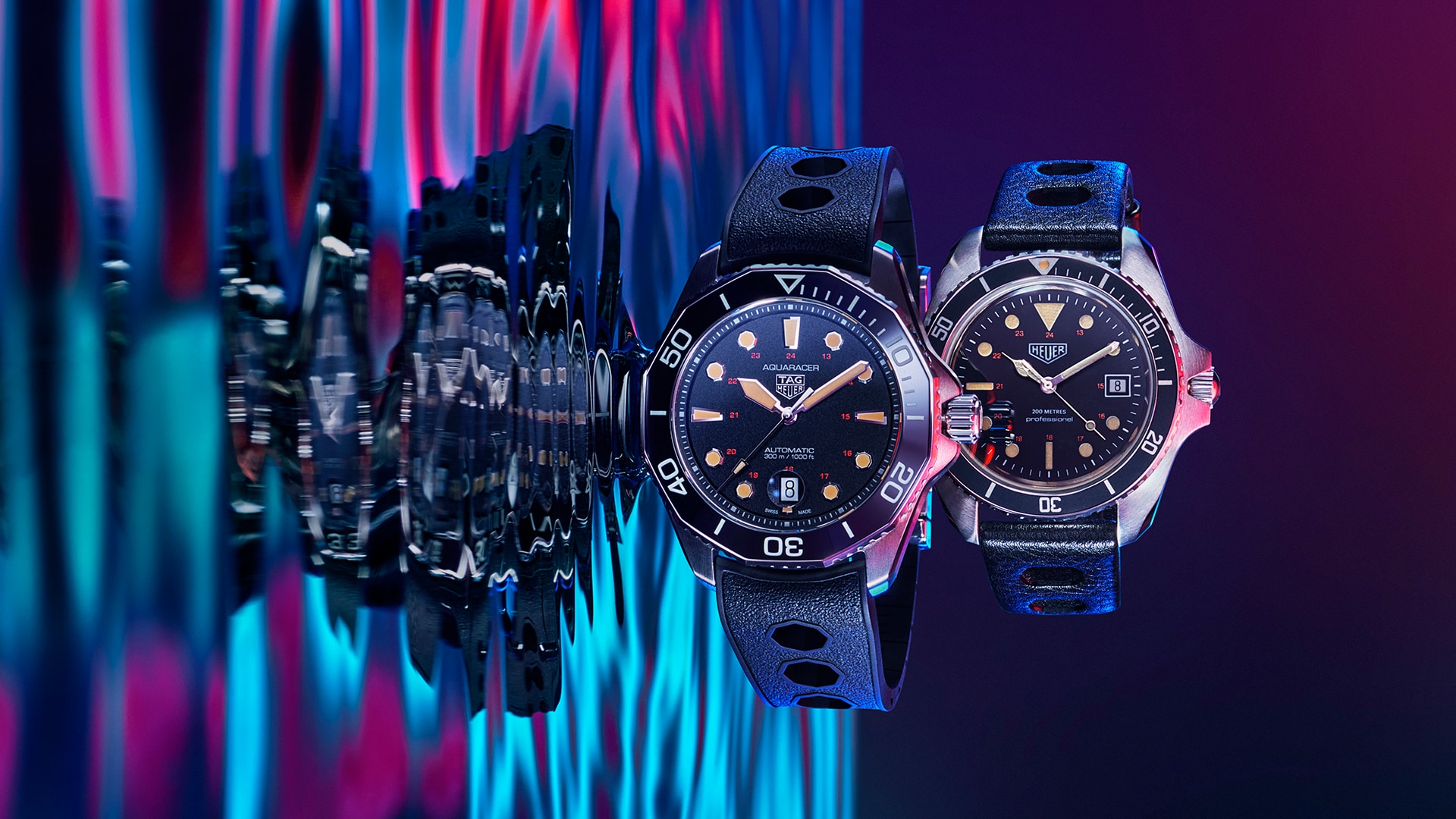
Invariably, the collections of watches offered by a brand will go through cycles, driven by the preferences of enthusiasts, changing styles and the brand’s position in the market. Over the years, models may become larger and smaller, move between their utilitarian purposes and the desire for elegance, and even switch between different types of movements, mechanical and quartz. Add in the choice between simple three-hand watches and complicated chronographs, the brand will face even more choices. And so it has been for TAG Heuer with its collections of dive watches, introduced in the late 1970s, and responding to many different preferences of enthusiasts over the subsequent decades.
Heuer introduced its first series of dive watches in 1978 and this collection (which became the “1000 Series”) developed rapidly, as the watches proved to be very popular in the market. With the early 1980s being a very difficult time for the Swiss watch industry, for Heuer to have this successful collection of dive watches was tremendously important for the company. In order to build out from the success of the 1000 Series, in 1982 Heuer created the 2000 Series, a collection that would add some “fashion” to the dive watch category, with a broad variety of styles, colors and materials. The 2000 Series would cover even more territory, also adding chronographs to its core of three-hand dive watches.
From its creation in 1982 through to 1998, the 2000 Series moved through three generations, as described in our article on the collection. To meet broad demand for different styles of dive watches and chronographs, this third generation of the 2000 Series was divided into three series -- “Classic”, “Exclusive” and “Sport”. However, it soon it became clear that the entire 2000 Series should be redesigned and re-branded to incorporate the features of the “Sport” series. With this, the 2000 Series of dive watches moved to its fourth generation, with this new generation being named the “Aquaracer”.
While historically much of the TAG Heuer catalog has been focused on motorsport or aviation, the Aquaracer collection stands apart as the series of watches that are purpose-built for water sports, such as sailing and diving. The Aquaracer continues as the collection in today’s TAG Heuer line-up that has continuously maintained the “Six Features” since launch and the Aquaracer remains a direct descendant of the Heuer range of diving watches that was introduced in 1978. While the Autavia, Carrera and Monaco collections had their origins on the 1960s, the 2000 Series and therefore the Aquaracer has the longest continuous production of any TAG Heuer collection, totaling more than four decades.
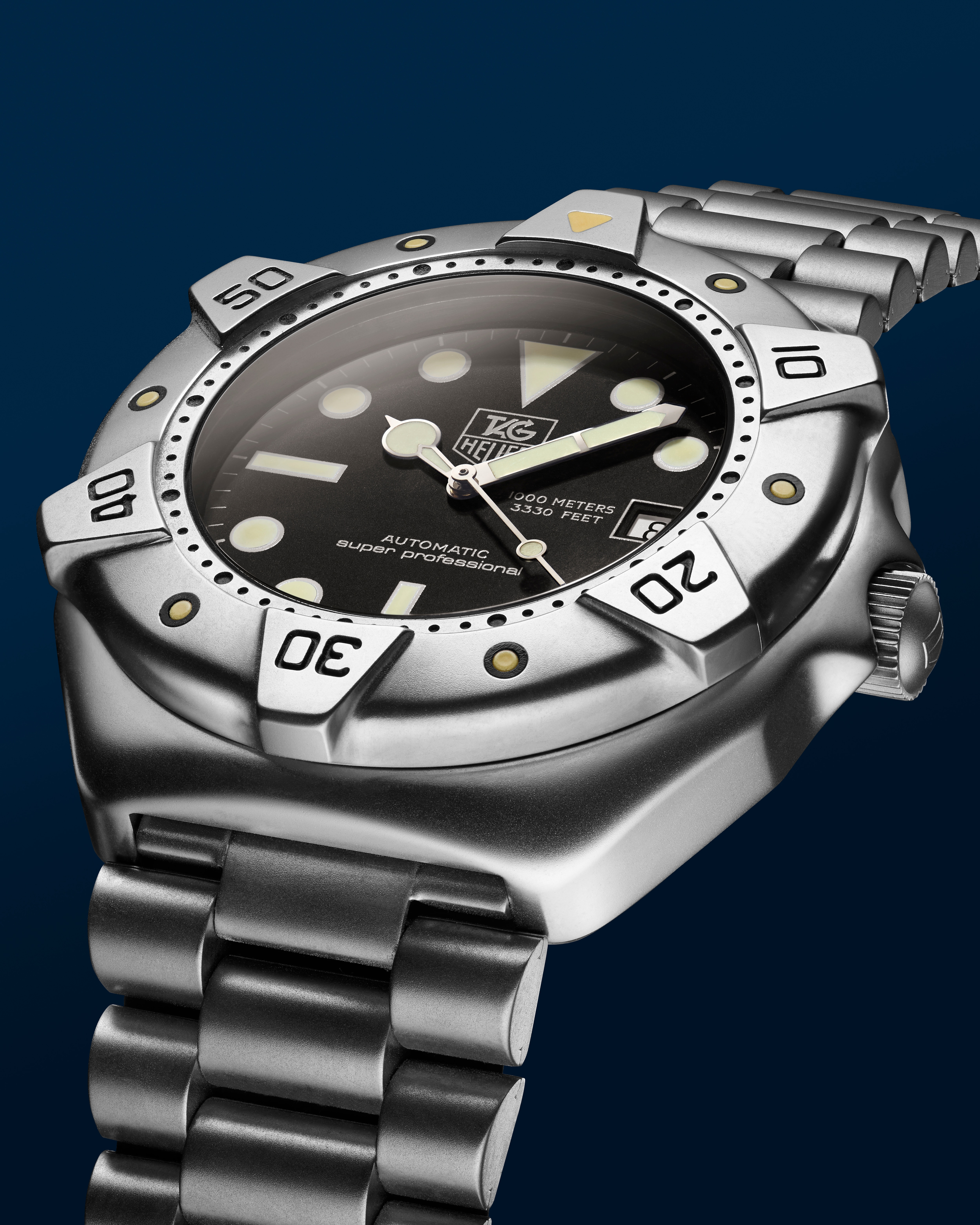
ORIGINS OF THE AQUARACER
The third generation of the 2000 Series came in 1998, when the collection was divided into three lines — the 2000 Classic, the 2000 Exclusive and the 2000 Sport models. The 2000 Classic watches continued the traditional style of the 2000 Series watches. The 2000 Exclusive models were bolder, with a heavier, stronger looking bezel, restyled hands and oversized numerals on the dial at 6, 9 and 12.
The 2000 Sport models (the predecessor of the Aquaracer) had an aluminum bezel with prominent lume-filled numerals around the dial. These 2000 Sport models took some style elements from the very first Heuer dive watches, including the traditional Mercedes style hands and the red / black bezel. There were relatively few models in this first line-up of 2000 Sport models, as the 2000 Sport line would soon be replaced by the new Aquaracer model.
After a short run, the 2000 Sport series was discontinued in 2002, but returned in 2004, as the 2000 Aquaracer. As such, the Aquaracer represents the fourth generation of the 2000 Series dive watches.
On the very first Aquaracer models, dials were marked “Professional”, rather than “Aquaracer”, but catalogs and advertisements referred to the new model as the 2000 Aquaracer. Defining features of the first iteration were aluminum bezels to match the dial, a yellow second hand so that the diver can easily see that their watch is operating, and waterproofing increased from 200 metres to 300 metres. The first 2000 Aquaracer models met with great success, prompting TAG Heuer to relaunch the full 2000 Series model line as the “Aquaracer” in 2005.
2005- 2009
The decision to re-brand the entire 2000 Series collection as the Aquaracer was consistent with LVMH’s strategy of renaming the legacy TAG Heuer watches (such as the S/el and Link) in line with the introduction of more premium finishing and materials and the use of more mechanical movements to supplement the quartz options.
In making the transition from the 2000 Series collection to the Aquaracer collection, TAG Heuer used the following naming convention:
- The 2000 Classic and Elegance series were renamed as “Aquaracer”
- The 2000 Aquaracer became the Aquaracer 300m
- The 2000 Aquagraph chronograph was simply the “Aquagraph”
- New Aquaracer models were launched
There were two case sizes offered for the new Aquaracer range - 38.4mm (principally the quartz watches) and 41mm (mainly the automatic range).
AQUARACER CALIBRE 16 CHRONOGRAPH
The first of the Aquaracer Calibre 16 Chronograph watches, reference CAF2110, came in a 41mm case in 2005 in three dial colours: black, blue and silver. TAG Heuer added a second Calibre 16 Chronograph, reference CAF2010, to the range in 2006, this time with a Day-Date feature and a circular pattern on the outer edge of the dial. The Day-Date model used a 43mm case, while the date-only model continued with a 41mm case.
In addition to their different dials, the two Calibre 16 models feature different chronograph pusher designs: round pushers on the earlier 41mm model and rectangular pushers on the later version.
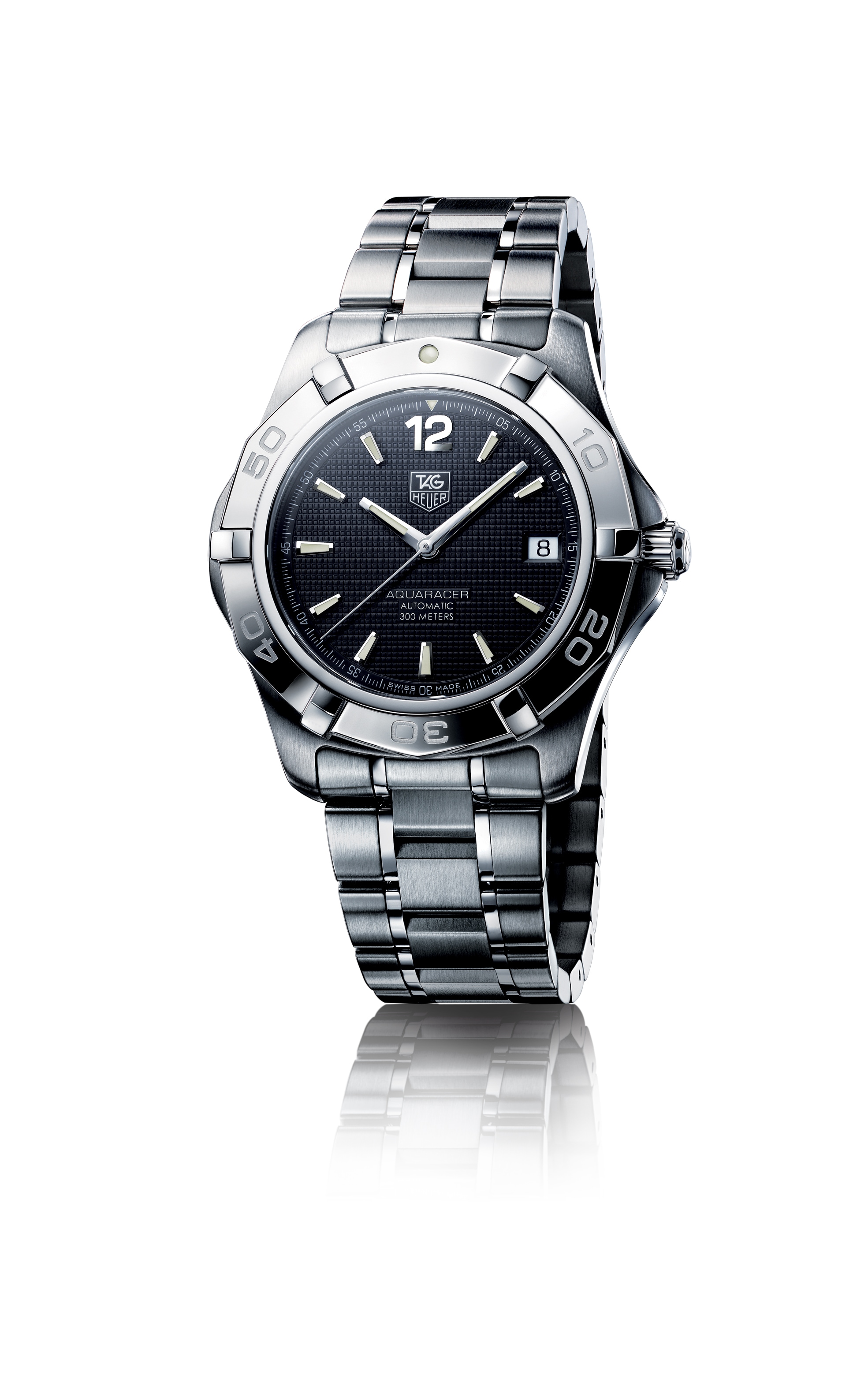
AQUARACER QUARTZ WATCH AND 300M 1/10TH CHRONOGRAPH
The 38mm Quartz model was the closest in design to the previous 2000 series and featured an updated dial design, new hands and hour-markers, as well as a new bezel which had larger 10-minute markers and larger, highly polished bezel studs. While the basic case shape stayed the same, in fact tracing its origin back to 1982, the size increase slightly from 37.2mm to 38.4mm. Another quartz option is the range was the 1/10th Chronograph model, which used the same case design and round pushers as the 41mm Calibre 16 chronograph. There were three dial colors, each with contrasting registers – black with white registers (CAF1110), silver with blue registers (CAF1111), and blue with white registers (CAF 1112).
As was the generally the case on all TAG Heuer watches from this period, the coloured TAG Heuer logo is used on Quartz models, while the monochrome logo was used on automatic watches.
AQUARACER AUTOMATIC WATCH
The Aquaracer automatic watch continued to use the Clous de Paris dial pattern (a guilloche pattern of hollowed lines that intersect to form tiny pyramidal shapes, sometimes called “hobnail”) as was used on the automatic 2000 series, but with the upgraded hour-markers, hands and bezel in line with the changes made to the quartz three-hand watch. The dials were marked Automatic 300 meters. All watches in this range use the Calibre 5 movement and shared the same 38.4 mm case.
OTHER MODELS
Over the four years of the first generation Aquaracer, TAG Heuer introduced several niche models, many of which used the Calibre 16 Chronograph case. For example, there were two Grand Date models from 2008, with subsidiary dial designs echoing that those of the Carrera Calibre 1 (running seconds at the bottom of the dial, in a semi-circular form).
The innovative Calibre S movement found its way into the Aquaracer, as did a quartz/analogue hybrid movement in the Aquaracer Chronotimer shown below left. The Chronotimer was also available with a bright yellow dial (CAF1011).
MOVEMENTS
The following is the range of movements offered across the first Aquaracer series, in many instances continuing over the years.
- Aquaracer 300m: ETA F06 111
- Aquaracer Calibre 16 Chronograph: Valjoux 7750
- Aquaracer Calibre S: TAG Heuer Calibre S
- Aquaracer Quartz Chronograph: ETA 251.262
- Aquaracer Automatic: Calibre 5
- Aquaracer Chronotimer: ETA E20.321
2009-2012
The second generation Aquaracer saw the series range divided into two. The traditional rounded case design continued with a variety of movements and designs, while a new more angular, sharp-edged case was introduced to support a new collection: the Aquaracer 500m.
AQUARACER 500M CALIBRE 5 WATCH AND CALIBRE 16 CHRONOGRAPH
The Aquagraph chronograph was introduced in 2003 and had a 500 meter depth rating, but with the Aquagraph being discontinued TAG Heuer needed a hard core dive model with this 500 meter rating.
The first Aquaracer 500m from 2009 was a modern classic - a bold new case, eliminating the curves of the original 2000 Series, featuring an innovative rubber-ridged bezel with applied metal numerals, an over-sized crown, and a helium escape-valve. The new 500 meter Aquaracers had vertical ribbing on the dial, and on the Calibre 5 and quartz models, the date window was positioned at 9 o’clock with a cyclops.
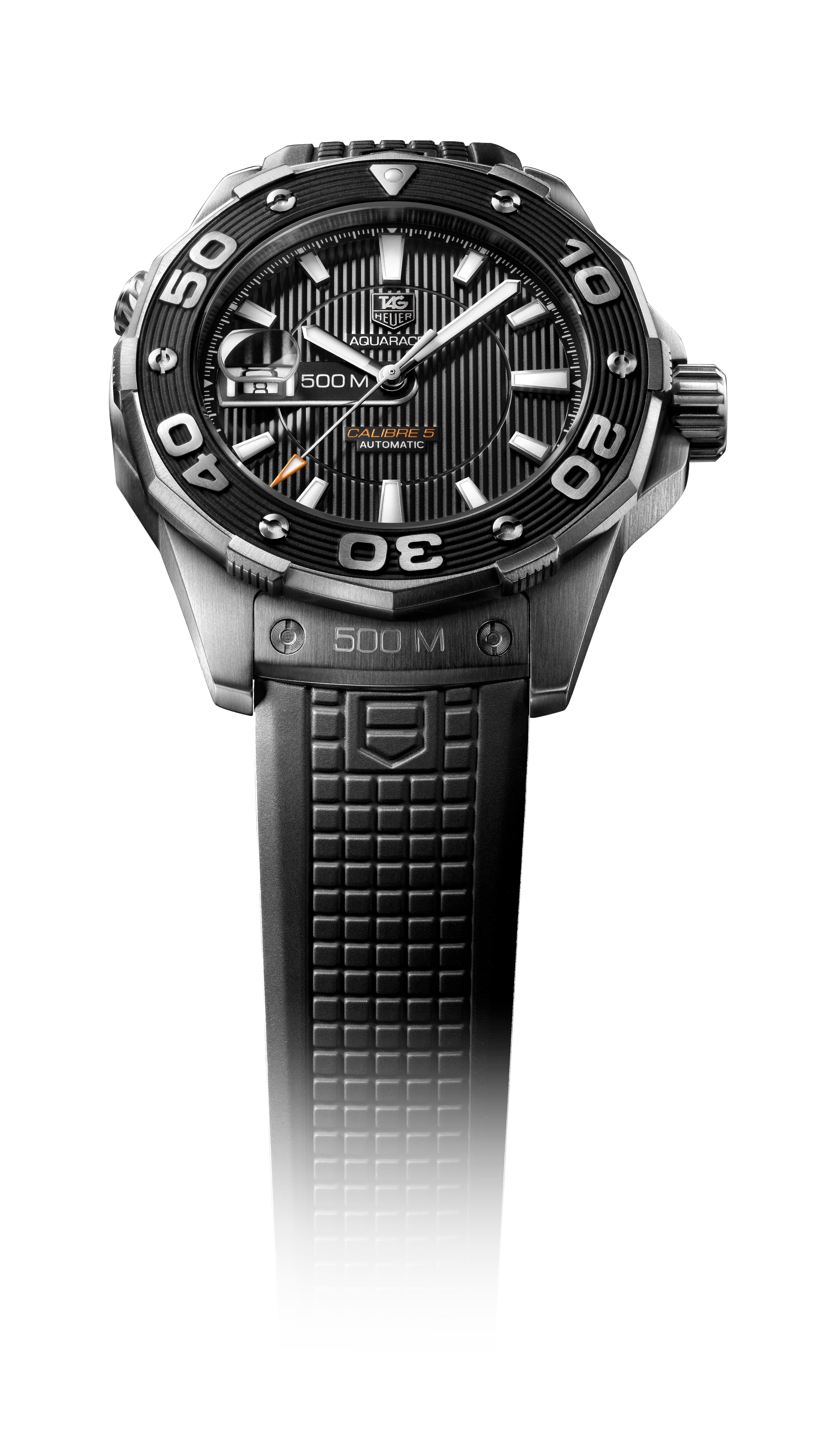
The changes extended to the newly designed rubber straps, which were now fitted with end-pieces featuring ornamental screw heads.
Sitting atop this new range was the Aquaracer 500m Full Black (WAJ2180), a blackened titanium case and dial offset by yellow lume on the hands and hour-markers.
AQUARACER 300M RANGE
Alongside the new Aquaracer 500m was the 300m series, which extended across quartz and mechanical 3-hand watch models, as well as an alarm variant (WAP1112), a Calibre 16 Chronograph (CAP2112) and a Grand Date offering (WAF1014).
These models continued the traditional Aquaracer look, offering a more sober and sophisticated design than the bold new 500m models.
2012-2014
In 2012, TAG Heuer introduced a revised version of Aquaracer 500 meter models, replacing the edgy design of the previous 500 meter case with a more traditional, softer style of case, with an important new innovation – a ceramic bezel. The case size moved from 43 millimeters to 41 millimeters and the ribbing on the dial was now horizontal, with the date moving back to the traditional 3 o’clock position. Stainless steel models included a black dial (WAK2110), a blue dial (WAK 2111), a champagne dial (WAK2121) and a blue dial in a bi-metallic model (WAK2120). For the first time, the Aquaracer was available in a full black case, made of titanium carbide (WAK2180).
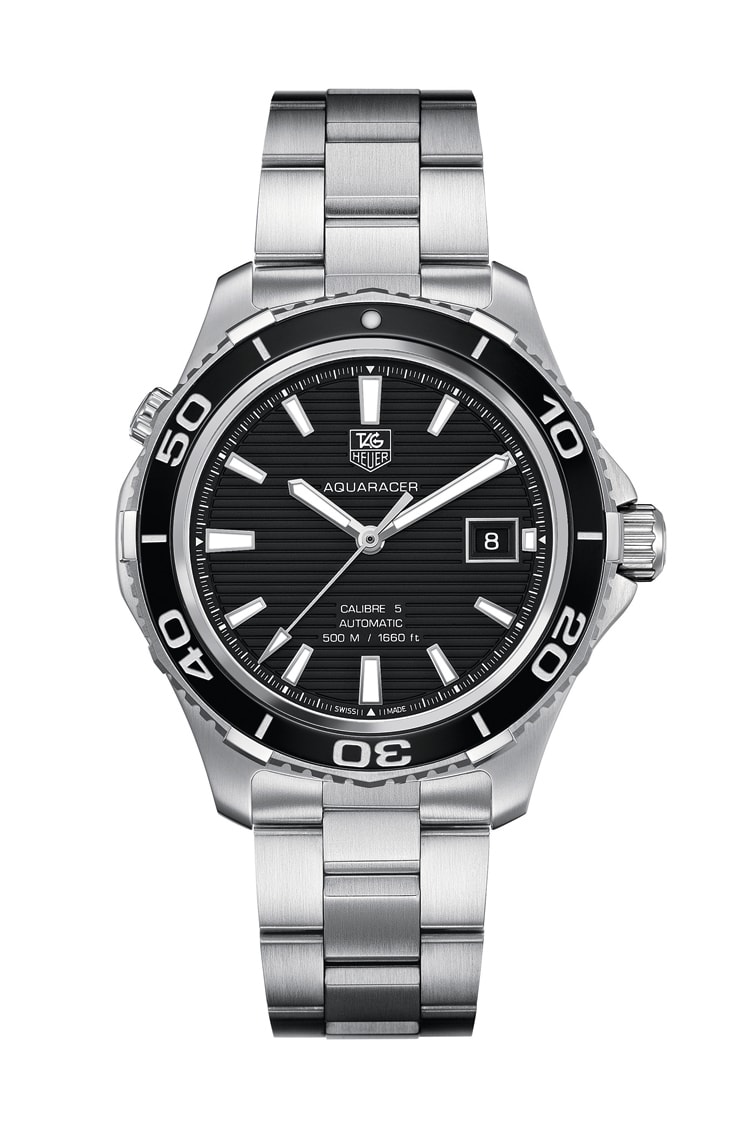
AQUARACER 500M CHRONOGRAPH CALIBRE 16 AND CALIBRE 72
There were two automatic chronographs available in the third generation Aquaracer range, both in stainless steel 43 millimeter cases -- the “traditional” Calibre 16 and a new Calibre 72 Countdown Chronograph. The Calibre 72, named in honor of Oracle Team USA’s 72 foot catamaran, chronograph was available as either an Oracle Team USA America’s Cup Limited Edition (CAK211B) or a standard production model (CAK211A).
2014- 2021
The fourth generation Aquaracer series saw the end of the Aquaracer 500m series, with two newly designed Aquaracer 300m families: one with a steel bezel and the other with a coloured ceramic bezel.
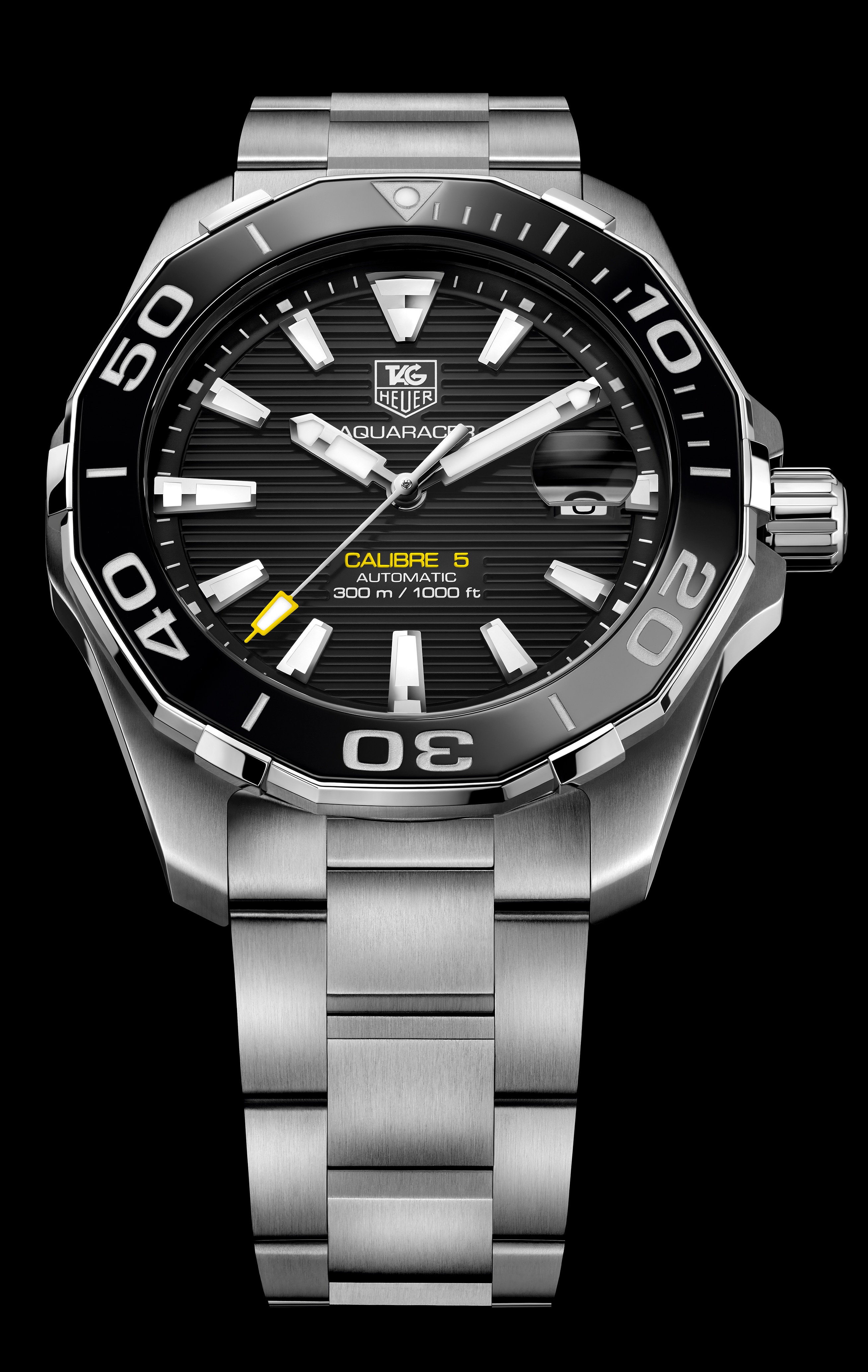
Perhaps the biggest change in the Generation four series was a new bezel design, with the serrated edges of the previous generation being replaced by flat edges. Moving to the dial, the new Aquaracer 300m family featured enlarged polished triangle-shaped indices and a new, larger hand-set with a coloured tip on the sweeping seconds hand.
AQUARACER 300M CALIBRE 5 STEEL BEZEL
The first model to introduce this new shape was the 2014 Aquaracer Calibre 5 watch, which carried over the patterned dial of the previous model. The Aquaracer 300m used a 40.5mm steel case, with a combination of brushed and polished finishes, and attached, there was a freshly designed rubber strap on offer, as well as the TAG Heuer “H-Link” bracelet first introduced on the Grand Carrera series.
In 2017, a second Calibre 5 model was added with the same hour-markers and hands as its ceramic-bezelled version and is distinguished by the use of coloured “Calibre 5” printed on the dial. A cyclops was also added over the date window.
AQUARACER 300M CHRONOGRAPH STEEL BEZEL
The look of the Calibre 5 model extended into two chronograph options: the quartz 1/ 10th Grand Date model and the automatic Calibre 16 model. Both these chronographs used a larger 43mm steel case.
There was also a new mechanical chronograph option, the Calibre 45, with its 54 jewel movement. This model had the chronograph minute recorder at 9 o’clock and the hour recorder at 6 o’clock, with running seconds at 3 o’clock. Featuring a prominent date window at the top of the dial, this model was called the “Big Date”.
AQUARACER 300M CALIBRE 5 CERAMIC BEZEL
In 2015 the new Ceramic Bezel Aquaracer 300m replaced the Aquaracer 500m series. Based on the steel-bezel watch, the Aquaracer 300m Ceramic received even larger hour-markers. The Calibre 5 series was initially available in a 41mm case, with a larger 43mm option added in 2016.
AQUARACER 300M CALIBRE 5 CERAMIC BEZEL- SPORTS MODELS
2017 brought the introduction of what collectors have called a “sports” series of Aquaracer Calibre 5 watches. Variations include finishes such as camouflage-pattern dials and vibrant colours, including matching straps. A model with a carbon-fibre bezel was introduced in 2018.
AQUARACER 300M CALIBRE 16 CERAMIC BEZEL
The Aquaracer 300m ceramic bezel family also includes a 43mm Chronograph range, which adds the design flourishes of the Calibre 5 watches to the larger chronograph case.



